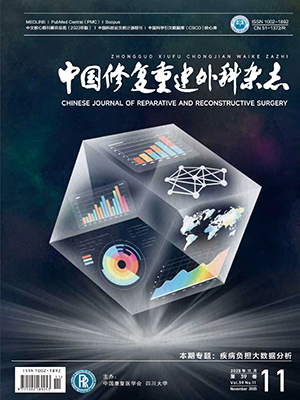Objective To compare the difference of traumatic related index in serum and its significance between minimally invasive transforaminal lumbar interbody fusion (MIS-TLIF) and open TLIF. Methods Sixty patients were enrolled by the entry criteria between May and November 2012, and were divided into MIS-TLIF group (n=30) and open TLIF group (n=30). There was no significant difference in gender, age, type of lesions, disease segment, and disease duration between 2 groups (P gt; 0.05). The operation time, intraoperative blood loss, and postoperative hospitalization time were recorded, and the pain severity of incision was evaluated by visual analog scale (VAS). The serum levels of C-reactive protein (CRP) and creatine kinase (CK) were measured at preoperation and at 24 hours postoperatively. The levels of interleukin 6 (IL-6), IL-10, and tumor necrosis factor α (TNF-α) in serum were measured at preoperation and at 2, 4, 8, and 24 hours after operation. Results The operation time, intraoperative blood loss, and postoperative hospitalization time of MIS-TLIF group were significantly smaller than those of open TLIF group (P lt; 0.05), and the VAS score for incision pain in MIS-TLIF group was significantly lower than that of open TLIF group at 1, 2, and 3 days after operation (P lt; 0.05). The levels of CRP, CK, IL-6, and IL-10 in MIS-TLIF group were significantly lower than those in open TLIF group at 24 hours after operation (P lt; 0.05), but there was no significant difference between 2 groups before operation (P gt; 0.05). No significant difference was found in TNF-α level between 2 groups at pre- and post-operation (P gt; 0.05). Conclusion Compared with the open-TLIF, MIS-TLIF may significantly reduce tissue injury and systemic inflammatory reactions during the early postoperative period.
Citation: ZOU Shu,WANG Jian,PAN Wenqi,ZHENG Yong,Huang Bo.. COMPARISON OF TRAUMATIC RELATED INDEX IN SERUM BETWEEN MINIMALLY INVASIVE AND OPEN TRANSFORAMINAL LUMBAR INTERBODY FUSION FOR TISSUE INJURY. Chinese Journal of Reparative and Reconstructive Surgery, 2013, 27(8): 960-964. doi: 10.7507/1002-1892.20130209 Copy
Copyright ? the editorial department of Chinese Journal of Reparative and Reconstructive Surgery of West China Medical Publisher. All rights reserved




